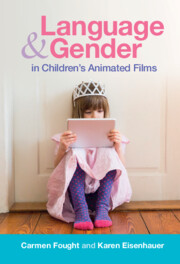8 results
9 - Conclusion
-
- Book:
- Language and Gender in Children's Animated Films
- Published online:
- 01 September 2022
- Print publication:
- 08 September 2022, pp 204-220
-
- Chapter
- Export citation
6 - Insults
-
- Book:
- Language and Gender in Children's Animated Films
- Published online:
- 01 September 2022
- Print publication:
- 08 September 2022, pp 131-154
-
- Chapter
- Export citation

Language and Gender in Children's Animated Films
- Exploring Disney and Pixar
-
- Published online:
- 01 September 2022
- Print publication:
- 08 September 2022
3 - Sensibility
-
- Book:
- The Dreadful Word
- Published online:
- 03 March 2022
- Print publication:
- 10 March 2022, pp 62-126
-
- Chapter
- Export citation
Chapter 5 - ‘What Is This Monster?’ The ‘Bad’ Politique
- from Part III - C. 1588–94
-
- Book:
- Politics and ‘Politiques' in Sixteenth-Century France
- Published online:
- 08 June 2021
- Print publication:
- 17 June 2021, pp 167-202
-
- Chapter
- Export citation
Conclusion
-
- Book:
- On the Offensive
- Published online:
- 06 October 2020
- Print publication:
- 15 October 2020, pp 251-254
-
- Chapter
- Export citation
1 - I’m Not a Racist, But …
-
- Book:
- On the Offensive
- Published online:
- 06 October 2020
- Print publication:
- 15 October 2020, pp 11-54
-
- Chapter
- Export citation
Introduction
-
- Book:
- On the Offensive
- Published online:
- 06 October 2020
- Print publication:
- 15 October 2020, pp 1-10
-
- Chapter
- Export citation



